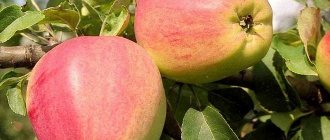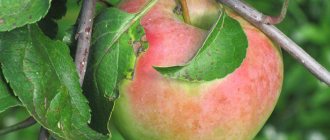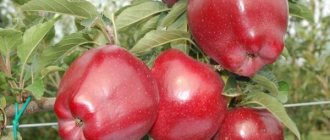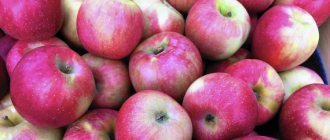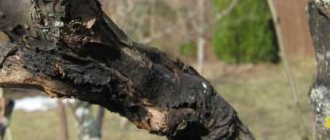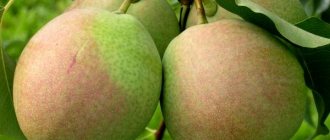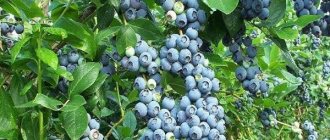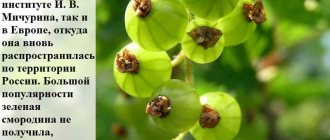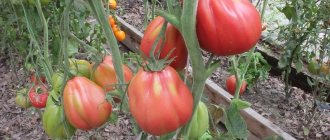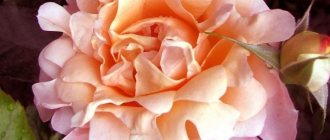» Gardening » Apple tree » Sinap apple tree - characteristics of the variety
0
1886
Article rating
Apple trees, like people, have their own destinies. Some have happy and cloudless ones, others have dramatic ones. The history of this tree is like a hard-boiled detective story: first, worldwide recognition, then undeserved oblivion, and finally, a long and successful life with numerous offspring. This is the Sinap apple tree.
- Advantages and disadvantages
- Landing
- Deadlines
- Technology
- Care
- Watering
- Top dressing
- Pruning and crown formation
- Basic rules for formative pruning
- Features of ripening and fruiting
- Harvest and storage
- Apple varieties based on Northern Sinap
- Khakassian
- Minusinsky
- Mountain
- Belorussian
- Reviews from gardeners
Apple tree Sinap - characteristics of the variety
Description and characteristics of the variety
First, you should familiarize yourself with a number of features inherent in all varieties of the variety.
Tree
The plant is large and tall, often growing up to 5 meters. Existing dwarf varieties do not exceed three meters. They all have a pyramidal crown with a huge number of shoots. There are no skeletal branches. Because of this, the crown appears sparse.
This is a very prolific apple variety
Gray-green or dark green leaves are ovoid in shape and do not densely cover the shoots. The edge is slightly raised, but the leaf blade is directed downward. The inflorescences are large and fragrant. According to the type of fruiting - mixed, but it is better if pollinating trees grow near the fruit plants.
The frost resistance of the variety is average and even northern varieties cannot withstand temperatures below -28°C.
Did you know? According to pomologist L.P. Simirenko, the Sinap Kandil variety produced a record harvest in 1883
-
1392 kg.
Unfortunately, now the tree produces no more than 200–300 kg
.
Apples
The fruits are medium or large, with an average weight of 120–150 grams. Excellent sweet and sour taste and juiciness does not depend on the variety.
Unripe apples are yellow in color with a greenish tint. During storage, the color may acquire golden tones. The barrel, which was constantly illuminated by the sun, will turn red. The skin is dense, rough, but easy to peel off. During long-term storage it becomes covered with an oily coating. The pulp is white, tender and aromatic.
Important! The harvested fruits should take 3-4 weeks to ripen. Then all their taste characteristics will be revealed.
The variety bears fruit well, but not consistently. Peaks in yield are observed at intervals of 2-3 years. During these years, an adult tree bears about 170 kg of fruit, and in more favorable years - 2-3 quintals.
Main characteristics of an apple tree
The parameters (crown size, height) of any fruit tree depend on the characteristics inherent in the variety and the degree of cultivation of the soil. The more fertile its composition, the more powerful the root system and crown.
Appearance
The height of the tree directly depends on the type of rootstock. In the classic version, Sinap Orlovsky is grown on semi-dwarf rootstocks. From such seedlings 4-5-meter apple trees grow. The use of vigorous rootstocks allows you to grow taller apple trees (from 5 to 6 meters).
The tallest trees (7 m) are grown from seedlings on clonal rootstocks. In areas with high groundwater levels, Sinap seedlings are planted on dwarf rootstocks. Trees grow from 2.5 to 3 m.
| Name | Description |
| Branches, appearance | Strong |
| Branch growth | Up, the angle of departure is almost straight |
| Leaves (shape) | Oval flat or oval convex |
| Leaves (pubescence) | Present |
Productivity
Even old apple trees bear fruit annually. Yields are above average. Good care allows you to get from 130 to 170 kg of fruit from one tall apple tree. The yield of medium-sized apple trees is lower - 70 kg.
Taste qualities of fruits
The score for the taste of Sinap apple trees is 4.3-4.7. Apples should not be consumed immediately after harvesting; they must reach consumer ripeness for at least 1 month. At this time they acquire characteristic sweetness, softness, and juiciness.
The pulp of ripe Sinap apples contains about 9.5% sugars. The fruits are ideal for dietary nutrition: 100 g of pulp contains only 50 kilocalories.
Apples that have reached consumer ripeness have a rich, balanced sweet and sour taste.
Frost resistance
VNIISPK employees from the laboratory of resistance physiology conducted research to study the resistance of shoot and bud tissue to low temperatures. The conditions were simulated artificially. Of all the varieties, Orlovsky Sinap performed better than others; its wood and buds were not damaged at a temperature of -42 °C.
Disease susceptibility
Disease resistance indicators are average. Leaves and fruits are susceptible to scab. An outbreak of the disease can occur in summer or autumn with high air humidity. To preserve the harvest, preventive maintenance is carried out with biological preparations (fungicides):
- "Alirin";
- "Fitosporin";
- "Gamane."
Advantages and disadvantages
- The variety has many positive qualities:
- precociousness;
- high yield;
- good keeping quality of fruits;
- the fruit does not mold and does not change taste during storage;
- fruits tolerate frost well;
- good frost resistance of the tree;
- tolerate transportation well;
- versatility of the fruit.
- There is no less list of negative traits of the variety:
- begins to bear fruit in the fourth year;
- without spraying you can lose 40% of the crop;
- the tree is tall and spreading;
- yield depends on weather conditions;
- without rationing the harvest, its quality deteriorates;
- does not tolerate drought and reacts negatively to dew;
- When there is a deficiency of nutrients, it is affected by bitter pitting.
Variety varieties
The Sinap variety has a number of varieties with their own characteristics in appearance, as well as different requirements for cultivation.
Qandil
It is characterized by high yield. One tree can produce 300 kg. Fruit harvesting is possible with the onset of autumn. Medium-sized apples, no more than 140 grams, elongated. Their skin is smooth, yellow-green with a ruddy side. The pulp is juicy and sweet. This variety has good immunity to most diseases.
Video: Kandil apple tree
Mountain
A fast-growing winter variety with good frost resistance and immunity to scab. Produces round, large fruits weighing 170–300 g. The color is golden with a pink-red side. Sweet and juicy in taste. After collection they are stored for six months.
The fruits of Mountain Sinap have an attractive appearance and delicate aroma
Heroic
A vigorous, frost-resistant variety. It has good immunity to powdery mildew and scab. It bears large white-green fruits weighing 130–300 g. They have an excellent presentation and excellent taste. The harvest takes place at the end of September. Apples can be stored for 6-7 months without loss of properties.
Apples of the Bogatyrsky Sinap variety are stored for up to 7 months and are characterized by good transportability
Belorussian
A medium-fruiting, vigorous autumn variety with a dense and wide crown. Fruits early, resistant to negative temperatures and scab. It can grow in Siberia, for example in Krasnoyarsk. Fruits weighing 0.09–0.12 kg with a hard, golden skin. The pulp is light green, soft, juicy, sweet. The harvest is harvested at the end of September and stored for 7-8 months.
Sary Sinap (Crimean Sinap)
Medium-sized variety of late winter ripening with immunity to scab and powdery mildew. Yellow-green fruits with a pink side weigh no more than 120 g. Under the thick skin hides white, dense, sweet and sour pulp. The harvest can be stored until mid-spring.
Video: Apple variety Sinap Sary
Almaty
The variety is immune to scab and powdery mildew. The tree is medium in size and blooms with dark pink flowers. The fruits are formed weighing 0.11–0.15 kg. An unripe apple is yellow-green in color; when ripe, it is dark red. The pulp is white, juicy, sweet, loose. Harvest occurs at the end of September.
Khakassian
An autumn variety that grows up to 400–450 cm. It bears fruits weighing 170 g. Ripe fruits do not fall off. From one tree you can collect 50–60 kg of yellow-green oval apples. The variety tolerates low temperatures and drought well. The harvest lasts until May.
Khakass Sinap is resistant to frost, winter drying and damping off
Minusinsky
Medium-sized, small-fruited autumn variety. It begins to bear fruit from the fifth year of life and bears fruits weighing 50–60 g. They are yellow-green in color with a pink-purple barrel and juicy, sweet and loose pulp. It is immune to scab and tolerates frost well.
Orlovsky
This variety begins to bear fruit in the fourth or fifth year. It is impossible to obtain a normal harvest without pollinators, and even with them it will not exceed 70 kg. The apples are large, 110–120 g, round-conical. In the upper part they are slightly beveled and have blunt ribs. The skin is without roughness, oily, with a glossy sheen. It is colored yellow-green if the apple is not ripe, and golden yellow if it is ripe. There must be a ruddy side.
Video: Apples of the Orlovsky sinap variety
Sinap on a dwarf rootstock
An adult tree of this variety does not grow more than 300 cm. It bears fruit much earlier than others, at 2-3 years. Such compact sizes allow you to grow several trees in a small garden plot. You can graft any of the described varieties onto a dwarf rootstock and get a tree with the same characteristics, but compact in size and with early fruiting.
Northern (Siberian)
The variety is partially self-pollinating. Without pollinators, a tree can produce 40% of its harvest. It bears fruit in 5–8 years, and if grafted onto a dwarf rootstock, then in 2–3 years. Blooms with large pink flowers. The average weight of the fruit is 95–150 g. They are conical in shape, yellowish-green in color with a brown-red side. Technical ripeness is reached by the beginning of October. A mature plant yields 170 kg of harvest.
Video: Apples of the Northern Sinap variety
Features of ripening and fruiting
Apples of this variety ripen in the fall. They reach harvest maturity at the end of September – beginning of October. Fruits picked earlier can be ripened during storage.
Sinap is a late-winter variety; it can be stored in proper conditions until May. During storage, it does not lose its taste and beneficial properties.
Harvest and storage
Fruit harvesting must be carried out no later than the first ten days of October to exclude the possibility of frost. Apples should be stored in low wooden boxes. The temperature in the storage should be just above freezing, and the humidity should be about 80%.
Food experts advise laying apples with the stems down and adding natural preservatives between the layers of fruit:
- sifted and calcined river sand;
- peat crumb;
- sphagnum moss.
The monks of the island of Valaam preserved fresh apples until the new harvest by dipping each one in melted beeswax.
It helps to store juicy fruits by wrapping them in paper and sprinkling them with dry oak or maple leaves. It is not recommended to use spruce branches or shavings (sawdust) of coniferous trees: the fruits will absorb the aroma of pine needles.
Landing Features
The main thing to consider when planting any variety of the Sinap variety, except for the dwarf variety, is the size of the tree. It is difficult to grow more than one such plant in a small area.
Important! In the late winter variety, the fruits ripen completely already collected. This takes two to three months .
Selecting a location
For apple trees to feel comfortable, they need about 700 cm of free space . It is advisable to plant them on the sunny side. It is preferable that the soil be sandy or loamy. Acidity levels are below 6 pH. Groundwater should not come closer than 200 cm to the surface.
The apple tree will give a larger harvest when planted in the fall
Selection of planting material
It is advisable to buy seedlings in specialized stores . When purchasing, you should pay attention to the condition of the root system. In a healthy seedling it is well developed, without damage, rot, or signs of disease. The stem is without traces of diseases or defects. The bark should be smooth.
Video: Choosing an apple tree seedling
Direct planting technology
Planting work is recommended to be carried out in the spring, in March or April, or in the fall, in September-October. A pit measuring 1×1×0.8 m is prepared at the selected location. If planting several trees is possible, then 700 cm is left between the pits.
Rice. 1 - Planting a fruit tree, fig. 2 - Properly planted tree
The fertile layer is removed from the pit and mixed with 2 buckets of rotted humus, a bucket of compost, 0.5 kg of ash, 50 g of sodium sulfate and 100 g of superphosphate. Everything is thoroughly mixed. The bottom of the pit is lined with drainage made of crushed stone or broken brick. A fertile mixture is poured on top, which fills a third of the hole. A peg is installed in the center, north of the seedling.
Important! In order for the crown to grow better, it is recommended to shorten the central shoot by 0.4 m.
If the planting material has dry roots, they need to be torn off and the remaining ones left in water for 4-5 hours. Then you can land. The plant is placed in a hole on a mound of soil. Its root system is carefully straightened and sprinkled with earth. The tree is watered with 3-4 buckets of water and the ground is mulched with peat and humus.
Video: Instructions for planting an apple tree
History of creation
Kandil Sinap is a legendary southern apple variety , which at one time was considered one of the best achievements of breeding. Its origin is not known for certain.
It is believed that it occurred as a result of an accidental mutation of the famous Crimean variety Sara Sinap.
It is an indigenous Crimean variety, zoned in the Krasnodar Territory, Ingushetia, and Ukraine.
Not so long ago, Kandil Sinap plantings occupied about 8% of the apple orchards in Crimea. In recent decades, it has been replaced by early-fruiting varieties imported from Europe and America, and therefore is not used in industrial horticulture.
Tree care
The Sinap variety is very demanding in care. Without attention, fruiting will be poor and irregular.
Summer varieties also include the Medunitsa apple tree.
Irrigation rules and regulations
The apple tree is watered weekly . One tree needs 3 buckets of water. If the summer in the region is hot and dry, then the frequency of watering can be increased. After each irrigation procedure, the tree trunk circle is loosened so that the water is absorbed faster and a crust does not form on the surface, preventing air movement.
Watering is especially important during bud formation and fruiting.
Timing and rates of fertilizer application
Fertilizers are applied for the first time the next year after planting. Four feedings are needed per year. With the beginning of sap flow, the apple tree is fed with a mixture of humus and manure (0.5–0.7 kg per tree). With the appearance of buds, urea is added, 0.5 kg per plant. After flowering, a mixture of superphosphate, urea, and calcium chloride is used. The last time nutrients are added is after harvesting. Superphosphate diluted with water (30–50 g/10 l) is used.
Root feeding should be applied to the tree trunk
Crown trimming and shaping
Sinap apple trees are characterized by intensive branch growth, so in order for the crown to look neat, it must be shaped. We will tell you how to do this correctly below. In the first years, the branches are shortened by only a third. In subsequent years, pruning should be done so that only three tiers of branches remain. After this, all branches except fruit-bearing ones are removed.
Did you know? Apples do not sink in water because 20
–
25% of their mass is air.
Pruning is carried out in the spring before sap flow begins. All cuts must be treated with garden varnish.
Thanks to pruning, trees bear fruit regularly and the size of the fruit increases
Preparing for winter
The frost resistance of the variety is average, so the plant will not be able to survive frosts without preparation for winter . It is necessary to wrap the trunk with non-woven material and cover it with spruce branches to protect it from pests.
The tree trunk circle is watered abundantly before frost, and then mulched with sawdust, leaves, and peat. Young, non-fruit-bearing trees must be covered with completely protective material.
Reviews
Maksim. “Kandil Sinap is a wonderful variety. A dwarf form grows on my site: the fruits appeared in the second year after planting. Large, sweet, juicy. We eat them all winter, and we also make jam. Very pleased, I recommend this variety to everyone.”
Paul. “I have long wanted to plant the Kandil Sinap variety, I remember it from childhood. But it was stopped by the fact that the tree grows for a long time and begins to bear fruit late. I looked at the photo and description of the variety on the Internet and found out that thanks to modern technologies, this variety appeared on a dwarf rootstock. It grows in my dacha, I am very pleased. It is easy to care for such a tree. I strictly follow the growing technology and the apple tree responds with a bountiful harvest.”
Anna. “This is my family's favorite variety. Five years ago they planted it in the country on a semi-dwarf rootstock. We harvest regularly. We take care of the tree: we look after it, feed it, loosen the soil. The apples are large, juicy, aromatic. They made juice from them and stored them for the whole winter. A beautiful tree pleases the eye and provides the whole family with vitamins.”
Diseases and pests of the variety
Sinap apple trees have good immunity to powdery mildew and scab, the most common diseases. To prevent other diseases and pests from attacking the plant, it is enough to perform a number of preventive actions:
- Trim dry, diseased, or deformed branches in a timely manner to protect the tree from pests.
- To protect the fruits from the codling moth, it is necessary to treat the plant with a wormwood solution.
- A lack of calcium can cause bitter pitting. For preventive purposes, at the beginning of fruit formation, spray the crown with preparations containing calcium.
- In preparation for winter, apply organic fertilizers, dig up and mulch with peat or humus.
Growing Sinap apple tree
The Sinap apple tree began to grow in Crimea. Already in the 18th century it gained great popularity among gardeners. There is more than one version of how this variety was bred. The most popular of them says that previously in the Crimean territories in the gardens these fruit trees occupied 8% of the area. They appeared by chance, as a result of a mutation in the seeds of the Sinap Sarah subspecies.
Growing Sinap apple tree
Advice from experienced gardeners
A few recommendations for planting and care:
- Plant the seedling so that its root collar is 50–70 mm above the soil.
- Spray the crown with copper sulfate after harvesting, and with Bordeaux mixture before the buds open.
- Treat with calcium-containing preparations in the evening.
- When preparing a tree for winter, check the condition of its bark.
- Plant the apple tree in soil with neutral acidity.
Harvesting ahead of schedule is not recommended, as this can lead to a deterioration in the taste of the fruit and a reduction in shelf life.
A huge number of subspecies of the Sinap variety allows everyone to choose the best one for themselves and grow it. Fruits of any variety are tasty, juicy and can be stored for a long time. The only thing that needs to be taken into account is the large dimensions of the tree. Because of this, if the plot size is not large, it is better to grow dwarf trees.
Description, photo
Mountain Sinap apple tree is a winter variety of large-fruited apple tree , bred in the 1990s by breeders of the Gorno-Altai Research Institute.
It was tested in the gardens of the Altai low mountains, and in 2009 it was included in the State Register. Zoned in the West Siberian region.
The variety is winter-hardy, with good disease resistance.
An adult apple tree is a tree of medium height and medium vigor. The sparse crown has a rounded shape.
The apples are large. Their average weight is 95-100 grams , in favorable years - up to 170. The shape of the fruit is a truncated cone or cylinder, the ribbing is weakly expressed.
The main color is golden yellow, the outer color is sometimes brownish, more often crimson-red, blurred, and occupies a small part of the apple.
The white pulp is fine-grained, medium-dense, juicy.
The taste is rated as very good, sweet with noticeable sourness, the aroma is not bright.
Apples are stored until April, without losing their taste and maintaining a healthy appearance. Transportable .
ADVICE! The fruits are universally used; they are used for making compotes, desserts, baked goods, preserves, jams, consumed fresh and dried.
Watch the video of what the Mountain Sinap apple tree looks like:
